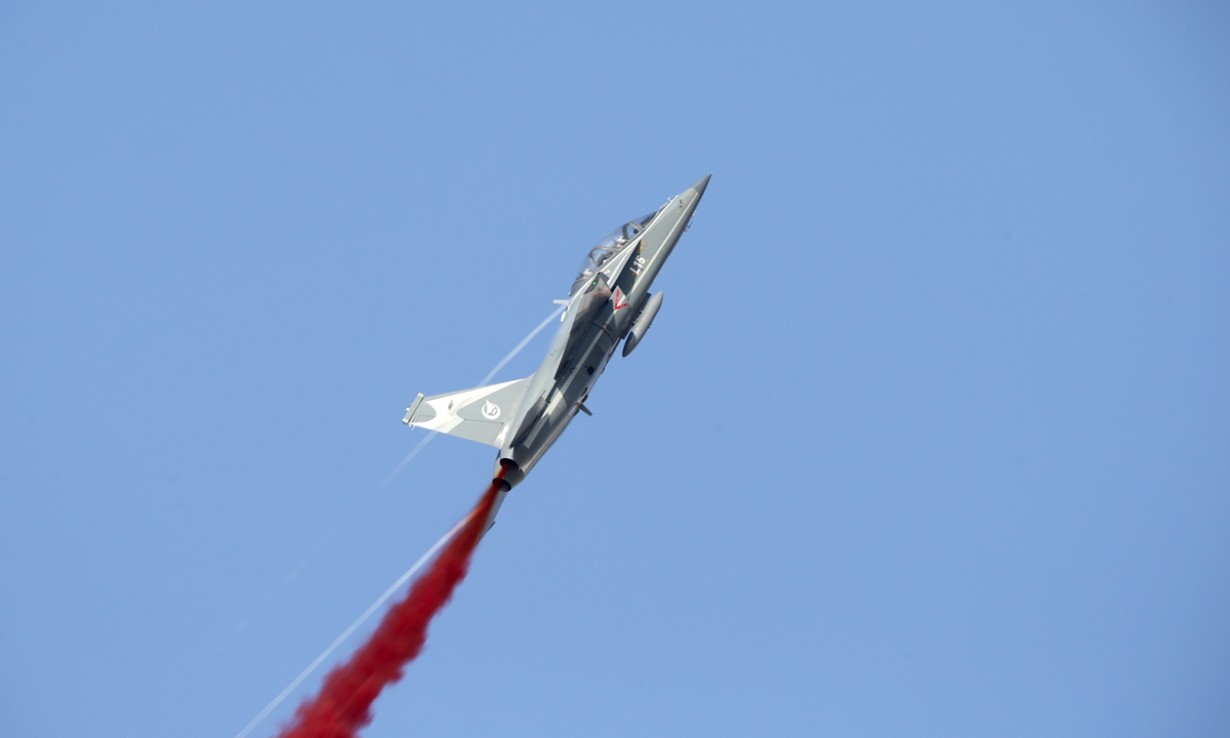After the JF-17 and J-10C, China has pitched L-15 (JL-10) Lead-in Fighter Trainer (LIFT) advanced jet trainers to Pakistan to replace its aging F-7PG fighters, currently used for operational conversion of Pakistan Air Force pilots.
This also reinforces that China has emerged as a major defense supplier to the debt-ridden country that faces an exponential spike in terrorism.
The PAF is also in dire need of acquiring new assets as it looks forward to retiring its aging fleet of aircraft in the next decade. The PAF will phase out its 250 aircraft. Amongst the aircraft being retired are its oldest fighter jets, the French-built Mirage III. Another fleet of Mirage 5 is also under the retirement plan.
The Hongdu L-15 Falcon, also known as JL-10, is a supersonic advanced jet trainer and light combat aircraft developed by the Hongdu Aviation Industry Corporation (HAIC). The aircraft is already in service in the Chinese Air Force. China’s National Aero-Technology Import & Export Corporation (CATIC) has confirmed during Dubai Air Show 2023 that Pakistan is in “formal negotiations” for the acquisition of L-15 LIFT fighters.
The L-15 took to the skies for the first time in 2006. Russia’s Yakovlev Experimental Design Bureau assisted China in its development. According to the manufacturer, the L-15/JL-10 can be configured as an advanced jet trainer or as a LIFT aircraft, with the LIFT variant capable of carrying a range of weaponry, including the PL-8 air-to-air missile and LS-6 satellite-guided bombs.
Its multi-role feature makes it a fit choice for the many security challenges Pakistan Air Force faces.
Reports suggest that Pakistan is interested in acquiring the light attack version of the twin-seater, twin-engine L-15 trainer. The plane is intended to train pilots for the Su-27, Su-30, J-10, and J-11 fighters. So far, Zambia and UAE have purchased the aircraft.

China sells the twin-seat L-15 Falcon for US $10 million to US $15 million per unit, industry reports said. This makes the jet significantly cheaper than many fighters produced by the United States or Europe.
Pakistan’s economy is facing the challenge of mounting debt, and the option of cheaper loans from China is a key factor for Pakistan’s military modernization budget.
The aircraft also features a digital fly-by-wire control system with a glass cockpit and integrated avionics. The LIFT variant is equipped with a locally developed passive electronically scanned array radar.
China’s inability to come up with an indigenous engine to power the aircraft has resulted in the Ukrainian Ivchenko Progress AI-222K turbofan powering the L-15/JL-10. The LIFT variant uses the afterburning AI-222K-25F model engine.
The Falcon’s two Ukrainian-built AL-222 turbofans afford the trainee and instructor a backup should one engine fail, while multi-function displays in the ‘glass cockpit’ and the hands-on-throttle-and-stick controls give trainees a chance to work with the kinds of instruments typical to fourth generation fighters.
The L-15 B model, with afterburning turbofans, allows the aircraft to attain speeds of 1.4 Mach. Its lengthened nose accommodates Passive Electronically Scanned Array radar and can scan both surface and air targets. A Radar Warning Receiver added in the tail gives it a fighting chance to dodge missile attacks, while an IFF antenna could help avoid friendly fire incidents.
The L-15B can carry nearly four tons of weapons loaded on nine hardpoints: six underwings, one belly pylon, and two wingtip rails. The instructor’s seat can instead be used by a Weapon Systems Officer to manage guided weapons. The aircraft can be armed with PL-5E heat-seeking air-to-air missiles (distantly related to the AA-2 and Sidewinder), LT-2 laser-guided bombs, and LS-6 GPS-guided bombs with fold-out wings that allow it to glide to targets up to thirty-seven miles away.
The L-15B can even lug jamming pods to serve as a cut-price electronic warfare jet. The jet can theoretically fly up to 52,000 feet high and over distances of up to 1,900 miles, but when fully combat-loaded, its effective radius is reduced to just 350 miles.
Cash-Strapped Pakistan Turns To China
Apart from LIFT L-15, Pakistan is also eyeing bulk orders of the Chinese-made next-generation aircraft J-10C. The PAF has already purchased 22 J-10 CE fighter jets. The deal also has a provision for a follow-up order of another 100 jets with specific enhancements.
The J-10C is a four-plus generation medium-sized fighter jet. The J-10C holds an upgraded jet engine than the China-Pakistan jointly developed lightweight fighter jet, the JF-17, currently used by the PAF.
There have been reports that PAF has been interested in KJ-500 early warning aircraft and Y-8 electronic warfare aircraft.
The JF-17 fighter jet, known as the “pearl” of Pakistan’s Air Force, is also reportedly facing maintenance woes as US sanctions disrupted supplies of spare parts in the global market.
One of the primary issues affecting the JF-17 fleet is the unavailability of spare parts and maintenance capabilities. Pakistan relies heavily on China for these components, and delays or disruptions in the supply chain can lead to grounded aircraft.
The exact number of inoperable JF-17s has not been publicly disclosed by the Pakistani authorities, but reports suggest that a portion of the fleet is currently grounded due to the challenges mentioned above.
- Ritu Sharma has been a journalist for over a decade, writing on defense, foreign affairs, and nuclear technology.
- She can be reached at ritu.sharma (at) mail.com
- Follow EurAsian Times on Google News




